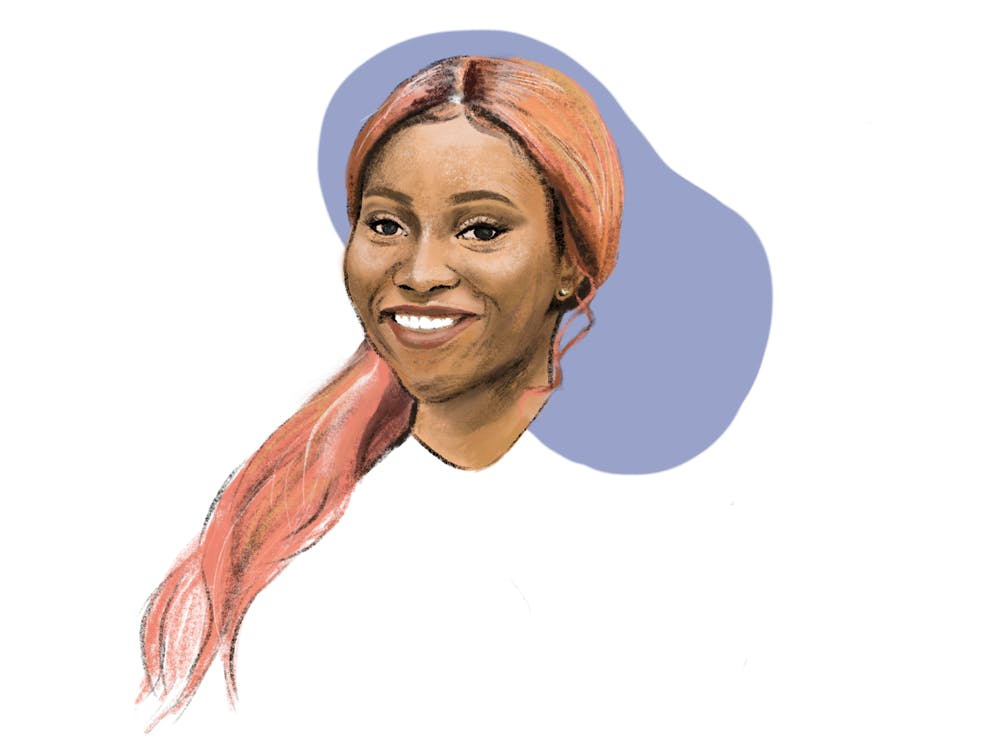The six hushed stories of Van Pelt watched over campus as Cynthia Dumizo (C ‘82) walked past College Hall and the ivy–lined fraternity houses that dotted Locust Walk. A seemingly mundane commute through Penn’s campus turned into a bitter memory in seconds as a student standing outside of a fraternity house caught Dumizo’s attention.
Nearly alone on an empty campus, “I was called the n–word,” she says.

Dumizo, now senior vice president at Bank of America and resident of Charlotte, North Carolina, had a college experience shaped in many ways by racial prejudice. However, for Dumizo and her peers, one crucial escape was the W.E.B. Du Bois College House, founded as a place for Black students to congregate, commiserate, and organize in a predominantly white academic space.
The house has served a critical role for Black students at Penn past and present. However, as renovations have made it a more desirable place to live, some Du Bois residents are concerned that it will no longer be a hub for Black student life.
The end of the 1960s brought larger numbers of Black students onto Penn’s campus than ever before, due in large part to the success of the Civil Rights Movement. But as Penn began to diversify its student body, many members of the Black community continued to feel unwelcome. More than a decade after major civil rights victories, Dumizo remembers multiple instances of Black students being stopped by police while going about their day.
Raymond Ragland III (C ’85), a physician and lifelong Philadelphian, witnessed hostile students throw eggs from the High Rise windows onto Black students celebrating and dancing below. The students ran into Du Bois for safety, which for Ragland, cemented the house’s role as both a literal and figurative shelter.

The Du Bois House was founded in 1972 by Penn student Cathy Barlow (C, W ‘71, L ‘76). During her time at Penn, Barlow noticed that, although barriers for the admission of Black students had been broken down, their experiences at Penn were far different from those of white students. According to Du Bois’ website, Barlow’s research found that a majority of Black students “dropped out in or before their second semester of senior year.” Due to Barlow’s efforts, Du Bois quickly became a center for Black culture, political organization, and academic support.
Ragland, who lived in Du Bois for three years, saw the house as the focal point of Black social life at Penn, remembering “100 people, Black kids” gathered around the house’s small TV to watch The Cosby Show on Thursday nights.
Ragland’s time at Penn also coincided with the wave of protests on college campuses against the apartheid government in South Africa. The house served as Penn’s own center of organization in the larger global movement.
“It was like being at an HBCU at an Ivy League school,” he says.
The Black undergraduate student population in Fall 2019 numbered 797—7.8% of total undergraduate enrollment—while Philadelphia itself is 43.7% Black. Though decades have passed since Du Bois was first created in response to Penn’s hostile racial environment, the house continues to serve as a home base for Black students on a mostly non–Black campus. However, some, including Kristen Ukeomah (C ’21), are worried that Du Bois’ cultural importance may soon disappear.
Kristen, who was raised in Prince George's County, Md.—"a very middle–class, Black community"—says she was shaped by watching the Black people around her succeed.
“I’ve always seen Black people doing well in just a positive light, and I feel like that’s what’s motivating me to be where I am today,” she says.
When it came time for Kristen to commit to a college her senior year of high school, seeing Du Bois made her decision easy.
“Seeing Black people happy—or at least pretending to be happy,” she notes with a laugh, “in Du Bois made me feel like, although [Penn is] predominantly white, there’s a very strong and happy Black community here too.”
“I didn’t even look at any other school,” she says. “Just being at Du Bois, I was like, ‘This is where I want to go to school.’”
Kristen emphasizes the role Du Bois has played in helping her to find success and community throughout her time at Penn. She describes two different worlds: the larger Penn community in which she feels pressured to push her Blackness to the side, and the world within Du Bois, where “you can be yourself and enjoy the different parts of your Blackness and not feel hated for that.”

Sitting in Van Pelt wearing a multicolored wrap in her hair, Kristen offers an example.
“I just came from Du Bois and I’m wearing a scarf; while I’d go to class, I probably wouldn’t. I’d have my hair out.”
Throughout her time at Penn, however, Kristen has seen Du Bois move in what she considers to be an unsettling direction. She says that every year, the student body of Du Bois has become less and less Black, a demographic trend that can be felt throughout the halls of the college house.
For years, Du Bois did not have air conditioning, making it a relatively undesirable choice for undergrads looking for the amenities in newer dorms like Hill or the historic experience of the Quad. Last summer, however, with the addition of air conditioning, many students have begun to see the house in a new light.
“Du Bois was basically nonexistent in non–Black spaces at Penn when it didn’t have AC,” says Ralph Tamakloe (E ‘22). Ralph, a resident of Du Bois for the past two years, notes that when previously asked about his residence by non–Black students, some had never even heard of the house. But the new air conditioning, in addition to the private living spaces and kitchens already offered in the dorm, have put it on more students’ radars. With this broader demand, Ralph and Kristen have seen unprecedented change.
Kristen, who is an Undergraduate Assembly representative as well as an active member of the Du Bois community, watched as the composition of the house changed over the course of only a few semesters. She decided to take on the challenge of preserving what she sees as one of the only truly Black–friendly spaces on campus.
She’s spent the past few months of the Spring 2020 semester speaking with the UA, administrators, and the College Housing and Academic Services staff in efforts to understand how residents of Du Bois are selected, as well as how the process can be changed to prioritize Black students and non–Black students interested in Black history and culture.
Currently, students are able to apply to live in Du Bois in the same way they apply to the High Rises or other residential buildings like the Quad or Hill. While Du Bois has more resources geared towards Black students, such as a program centered around Black cultural and political expression, there is currently no application or process for making Du Bois an intentionally Black space. In Kristen’s eyes, Penn must act to change this system.
But the junior has received pushback from administrators who say that Du Bois was never a program designed specifically for Black students. Some Du Bois residents and Black students have also expressed disagreement with the idea of changing the housing application, arguing that the community should be equally open to everyone. Barlow herself, the house’s founder, asserted in 2013 that the house was never designed to be a segregated dorm for Black students. But to Kristen, Du Bois shouldn’t necessarily consist of only Black students; it should also welcome non–Black students who “have an interest or a vested interest in African American culture.”
Alumnus Ragland supports efforts to maintain a cohesive house culture centered around Black life. He looks back fondly on his time in Du Bois as a formative and meaningful experience. He has also remained close with friends from the college house, raising his children alongside them and planning vacations together to this day.
“I would certainly say that based on my experience at the University, a place like that, which was so critical in my development, is still critical,” he says.
The fate of Du Bois, and of Black cultural spaces on campus in general, remains murky. Although university operations have been mostly suspended, questions around the house’s future application process are still as pressing as ever. Housing preferences for the Class of 2024 were due on May 4.
Although not affiliated with Kristen’s efforts, Ralph agrees that acceptance into Du Bois should be designed to maintain the community and cultural importance of the space. He says an uptick in non–Black residents has led to smaller turnout at Du Bois events, a pattern that dilutes the sense of community the college house tries to cultivate.
“The culture in Du Bois is all about celebrating Black history,” Ralph says. “There are things that we do that are specific to Black culture, and when people live there who are not interested in that, I guess there’s no point in it.”
